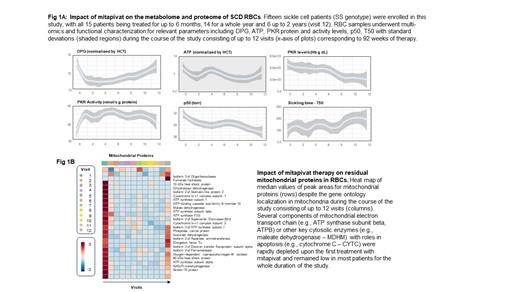2,3-diphosphoglycerate (DPG) in red blood cells (RBCs) stabilizes deoxyhemoglobin to promote hemoglobin (Hb) oxygen off-loading and counteract hypoxia. In sickle cell disease (SCD), mutation of glutamate 6 to valine in the beta chain of Hb results in HbS that polymerizes, causing RBCs to sickle upon deoxygenation in the tissues. Elevated DPG promotes sickling by stabilizing HbS fibers. DPG is an intermediate substrate in the glycolytic pathway in which pyruvate kinase (PK) is a rate-limiting enzyme. In a previous Phase 1 study (NCT04000165, Xu et al, 2022), we established proof-of-concept for activating PK as a viable anti-sickling therapeutic approach; mitapivat, an investigational oral allosteric activator of PK, decreased DPG and increased adenosine triphosphate (ATP) levels, improved hematologic and sickling parameters in patients (pts) with SCD (HbSS). Here, we investigated the changes in the metabolome, lipidome and proteome of RBCs from patients with SCD currently enrolled in an open label, Phase 1/2 study (NCT04610866) that evaluates long-term safety and tolerability of mitapivat in pts with SCD.
Fifteen pts with HbSS (aged 25 - 57 years, 10 males) were evaluated. All pts started mitapivat at 50 mg twice daily (BID), escalating after 4 wks to 100 mg BID; dose adjustments were performed for safety and tolerability, per PI discretion. At the time of data cutoff (March 23, 2023), all 15 pts completed the core period of 24 wks, 14 pts completed 48 wks ,10 pts completed 72 wks and 6 pts completed 92 wks. Leuko-depleted RBCs (LDRBCs) obtained from fresh whole blood in EDTA at baseline (V1, prior to drug initiation) and various longitudinal time points over the course of the study were flash-frozen in liquid nitrogen and kept frozen at -80°C until analysis. Clinical measurements of DPG, ATP, red cell PK (PKR) protein and activity levels, oxygen affinity (p50) and sickling kinetics (t50) were accompanied by multi-omics (metabolomics, lipidomics, proteomics) characterization of the LDRBCs. In total, 150 (6x12, 4x10, 4x8 and 1x6) timepoint samples were analyzed (Fig 1A).
Multi-omics analyses were performed through a stepwise extraction of metabolites, lipids and proteins on 50 µl of packed LDRBC pellets. Extracts were separated via ultra-high-pressure liquid chromatography coupled to mass spectrometry, prior to peak picking and identification of ddMS2 data as previously described (Thomas et al 2020). Statistical analyses were conducted using MetaboAnalyst v 5.0 and Rstudio upon normalization of relative quantitative data to visit 0 levels for each variable. Network analysis and pathway analysis were performed in OmicsNet v 2.0.
Mitapivat therapy had significant effects on the metabolome, lipidome and proteome of SCD RBCs. Overall, the temporal trends of omics responses to mitapivat treatment across visits was evident, especially when focusing on the top 50 metabolites/lipids or proteins by time series ANOVA. Specifically, results suggested a positive correlation between mass spectrometry-based quantitation of RBC mitapivat levels and DPG consumption, ATP accumulation, PKR activity (measured via enzymatic assays), and PKR protein levels, with internal consistency between omics data and antibody-based or enzymatic assays (Fig. 1A). The treatment also promoted activation of the Lands cycle, transient elevation of lysophosphatidylcholines and oxylipins, and depletion in free fatty acids within the first 6 months, suggestive of an effect on membrane lipid remodeling. SCD RBCs abnormally retain mitochondria; here, we showed a consistent decrease in the levels of residual mitochondrial proteins in RBCs within 4 wks of mitapivat treatment (Fig. 1B). In keeping with the predicted activation of PKR upon mitapivat treatment, we observed decreases in DPG and increases in ATP, with elevation in glycolytic fluxes, as inferred from longitudinal changes in glycolytic intermediates at the hexose and triose phosphate steps, as well as lactate. Unsupervised analyses of omics data confirmed the specificity of mitapivat on targeting late glycolysis, with glycolytic metabolites ranking as the top correlates to parameters of oxygen affinity (p50) and sickling kinetics (t50) during mitapivat treatment.
Multi-omics analysis of RBCs from HbSS patients treated with mitapivat identified benefits for glycolysis, DPG consumption and ATP generation, as well as activation of the Lands cycle.
Disclosures
D'Alessandro:Omix Technologies Inc: Current equity holder in private company; Macopharma: Consultancy; Hemanext Inc: Consultancy. Worth:Agios Pharmaceuticals Inc.: Current Employment, Current equity holder in publicly-traded company. Patil:Agios Pharmaceuticals Inc.: Current Employment, Current equity holder in publicly-traded company. Huston:Agios Pharmaceuticals Inc.: Current Employment, Current equity holder in publicly-traded company.


This feature is available to Subscribers Only
Sign In or Create an Account Close Modal